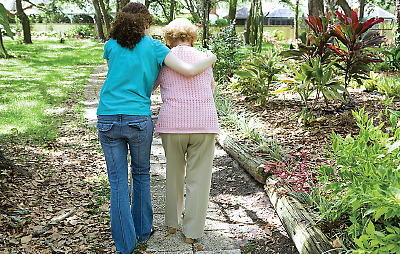‘DICE’ Rolls to New Approach for Treating Dementia Symptoms
Abstract
Neuropsychiatric symptoms affect 98 percent of individuals with dementia at some point in the disease course, so an approach that minimizes medication use would be welcome.
A new approach to alleviate agitation and aggression associated with dementia may help reduce the use of psychiatric medications that are often prescribed to individuals with neurocognitive decline—potentially making life easier for patients and their caregivers.

A team of neurocognitive experts from the University of Michigan and Johns Hopkins University proposed in the April 29 Journal of the American Geriatrics Society an alternative method to help reduce unfavorable neuropsychiatric symptoms (NPS) that are often associated with dementia.
“Often, more than memory loss, behavioral symptoms of dementia are among the most difficult aspects of caring for people with dementia,” said Helen Kales, M.D., lead author and director of the Section of Geriatric Psychiatry and the Program for Positive Aging at Michigan. “These symptoms are experienced almost universally. . . .”
According to the authors, NPS affects 98 percent of individuals with dementia at some period in the disease course, and NPS management accounts for 30 percent of the cost for caring for patients with dementia in community settings. Symptoms include depression, psychosis, agitation, aggression, apathy, sleep disturbances, and disinhibition.

Helen Kales, M.D. says it’s time to seek out other modalities for treating neuropsychiatric symptoms of dementia than the usual off-label use of psychotropic medication.
“These symptoms are often associated with poor outcomes including early nursing-home placement, hospital stays, caregiver stress and depression, and reduced caregiver employment,” explained Kales.
The Food and Drug Administration has not yet approved any medications to treat NPS associated with dementia, yet psychotropic medications are frequently prescribed to manage these symptoms. In the limited studies of proven pharmacological efficacy for NPS, it was suggested that significant risks for adverse effects could hamper the benefits of off-label use of the drugs. For this reason, Kales told Psychiatric News it’s necessary to seek out nonpharmacological treatment modalities.
The newly developed approach, dubbed DICE—which was presented last month to a standing-room-only audience at APA’s annual meeting—focuses on the implementation of behavioral and environmental modifications as a first-line method to alleviate neuropsychiatric symptoms.
The components of DICE, which is a four-step approach, are as follows:
D: Describe—Asking the caregiver, and the patient if possible, to describe the “who, what, when, and where” of situations in which problem behaviors occur and the physical and social context for them. These observations will be shared with caregivers. | |||||
I: Investigate—Having the health provider look into all aspects of the patient’s health, including dementia symptoms and current medications and sleep habits, that might be combining with physical, social, and caregiver-related factors to produce the behavior. | |||||
C: Create—Working together, the patient’s caregiver and health care providers develop a plan to prevent and respond to behavioral issues, including everything from changing the patient’s activities and environment to educating and supporting the caregiver. | |||||
E: Evaluate—Giving the provider responsibility for assessing how well the plan is being followed and how it’s working, or what might need to be changed. | |||||
The authors recommended that clinicians prescribe psychotropic drugs only after they and the patient and caregiver have made significant efforts to change unfavorable behaviors in dementia patients through environmental modifications and other interventions, with exceptions related to severe depression, psychosis, or aggression that present risks to the patient or others.
Proposed modifications that may aid in easing the burdens of patients with dementia and their caregivers included increasing patient physical activity to reduce boredom and feelings of irrelevance, increasing communication between patient and caregiver, and educating caregivers on underlying factors that may trigger NPS.
“Rather than ‘rolling the dice’ with the usual care approach of prescribing a medication with ‘risk/benefit’ concerns . . . the use of the DICE approach provides an evidence-informed pathway to conduct the assessment of behavioral symptoms of dementia . . . that can be integrated into diverse practice settings,” Kales stated.
The proposal for the DICE approach was funded by the Program for Positive Aging at the University of Michigan, the Johns Hopkins Alzheimer’s Disease Research Center, and the National Institutes of Health. ■
An abstract of “Management of Neuropsychiatric Symptoms of Dementia in Clinical Settings: Recommendations From a Multidisciplinary Expert Panel” can be accessed here.



